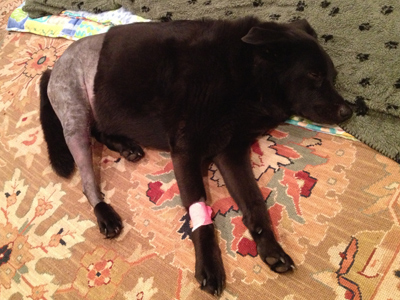
Your veterinary clinic will provide painkillers for you to keep your dog comfortable. Your dog may whine and howl the first night, this is also common and you can provide hands on comfort in tandem with a soft comforting voice. Even if your dog is not eating or drinking in the first 24 hours have water and food available in case this changes. Have water available for your dog in the recovery space that you have prepared, like food your dog may not drink much in the first 24 hours and you should not be alarmed. This must be kept on at all times until the sutures are removed.ĭo not be alarmed if your dog does not have an appetite the first day and night home, this is common and you can trust that hunger will resume within 24 hours. Your dog will need to wear a cone around the collar area of the neck to prevent him or her from licking the sutures or staples at the point of incision. The crate should be lined with blankets so that your dog does not slip and slide around. When you pick your dog up after surgery you will want to have a crate in the vehicle that you are driving to ensure that your dog is limited in movement during the drive home. Remember, your dog has been under anesthetic during a complex and invasive surgery and may appear disoriented when you initially greet him or her at the veterinary clinic: Be gentle and kind with your words and movements towards your dog. The First Day And Night At Home Post Surgery
#ACL SURGERY FOR DOGS FULL#
The first day and night that your dog spends at home post surgery will be an intense period of time for both of you, as well as crucial for the full recovery of your dog’s knee. Make all necessary preparations to your home prior to your dog’s return. A short leash should be easily accessible in this room so that you can take your dog for short controlled walks. You may want to have some puppy mats on the floor for the first few days in case your dog loses control of his or her bladder. If your home is not carpeted, you can put yoga mats, throw rugs or any other temporary matting down to prevent your dog from slipping and sliding. The recovery room should have non-slip floor, any slipping and sliding could harm the joint that has recently been operated on. The confinement room should also be comfortable for you, as you will be spending significant time in this space providing hands on comfort to your dog. If you are not going to be available for full time supervision you will need to have a crate in this room that is large enough for your dog to stand up and turn around in.

There should be food and water easily accessible in this space. Create a comfortable dog bed, as your pet will be spending a lot of time resting. Use a baby gate to block off entrances to this room, remove all furniture that your dog is habituated to jumping on or off of. Choose a room that will become the recovery space. You will need to confine your dog for the first several weeks after surgery. There is a lot that you can do to prepare your home so that your dog can enjoy a safe recovery period. Your dog is undergoing a complex and invasive surgery to his or her hind knee and you will need to severely limit activity, particularly all jumping after the operation.

Prepare Your Home Prior To Your Dog’s Arrival Post Surgery Learn in detail what to expect during each phase of post-operative care to ensure a full, speedy, and uncomplicated recovery for your dog.


Rehabilitation of the musculature around the operated knee, and increased activity throughout week two-six.The proceeding two weeks while the sutures and staples are still present.The first day and night at home after surgery.Home preparation prior to your dog’s return from the veterinary clinic.The time frame of post-operative care can be broken down into five primary phases: If you are considering ACL surgery for your dog or have already booked the operation then you will want to have a profound understanding of what to expect during the recovery phase. Anterior Cruciate Ligament (ACL) Surgery is a complex procedure on your dog’s hind knee joint that demands specific protocol during the post-operative phase to ensure a successful recovery.


 0 kommentar(er)
0 kommentar(er)
